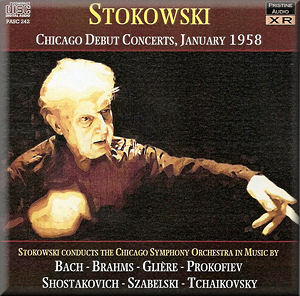 |
 |
|

Availability
Pristine
Classical |
Stokowski — Chicago Debut Concerts, January 1958
Johann Sebastian BACH (1685-1759)
Nun komm, der Heiden Heiland BWV 599 [5:33]
Komm, susser Tod BWV 478 [6:10]
Mein Jesu! was vor Seelenweh BWV 487 [6:20]
Wir glauben all’en einen Gott BWV 437 [4:26]
Boleslaw SZABELSKI (1896- 1979)
Toccata (1938) [6:15]
Sergei PROKOFIEV (1891-1953)
Romeo and Juliet suite (1936) Suite 1, VI Romeo and Juliet [9:18]: Suite 2, VI Dance of the Antilles Girls [1:23]: Suite 2, VII Romeo at Juliet’s Grave [7:03]
Pyotr Ilyich TCHAIKOVSKY (1840-1893)
Swan Lake — Suite Op.20 (1877) Act I Introduction [2:41]; Act I
No.5 Pas de deux [4:51]: Act 2 No.10 Scène [2:41]: Act 2 No.1 Danse
des Cygnes [6:09]: Act 3 O. 20A Danse Russe [2:27]; Act 3 N.21 Danse
espagnole [2:22]: Act 4 No.27 Danse des petits cygnes [4:53]: Act
4 No.29 Finale [1:52]
Johannes BRAHMS (1833-1897)
Symphony No.2 in D major Op.73 (1877) [39:05]
Reinhold GLIÈRE (1875-1956)
Symphony No.3 ‘Il’ya Muromets’ Op. 42 (1909-11) [40:07]
 Chicago Symphony Orchestra/Leopold Stokowski
Chicago Symphony Orchestra/Leopold Stokowski
rec. 2 and 9 January 1958, Orchestra Hall, Chicago
 PRISTINE AUDIO PASC242 [78:44 + 79:14]
PRISTINE AUDIO PASC242 [78:44 + 79:14] 
|
|
|
Stokowski’s debut with the Chicago Symphony came surprisingly
late – January 1958, a source of not-so-wry amusement to the
conductor, no doubt. The performances were taped by a New York-based
company and subsequently rebroadcast with studio voice-overs
added to try to add verisimilitude to the proceedings.
We have most of the fruits of two concerts in these two discs
– we are missing some Wagner items, and it’s been necessary
to mix them up to fit everything onto the discs. For the record,
the concert on 2 January contained Bach, Brahms and Szabelski,
while that on 9 January had a running order of Shostakovich,
Glière, Prokofiev and Tchaikovsky.
The Bach chorales were Stokowski staples. The quartet opens
with a memorial-like Nun komm, der Heiden Heiland before
embracing the deep-throbbing bass and pellucid harp textures
evoked in Komm, susser Tod. A powerfully sustained legato
runs through Komm, susser Tod whilst Wir glauben all’en
einen Gott opens with crisp wind statements before reaching
an almost overwhelming peroration. The audience is unsettled
throughout and coughs often. Szabelski’s Toccata is a brisk,
occasionally brusque orchestral showpiece, trumpet-punctuated
and sporting powerful percussion. Following it immediately with
the gloomy Shostakovich Prelude orchestration – one made by
Stokowski himself – makes for a piece of quixotic programming,
though as we know it wasn’t like this at the concert itself.
Stokowski mixes three pieces from the two Prokofiev Romeo
and Juliet suites to form a compact triptych. The rich cantilena
to be heard in the panel devoted to Juliet’s grave is augmented
by intense string tone and luscious portamenti. Equally ripely
characterised, though also a construction all of his making,
is the eight movement suite he assembled from Swan Lake.
The second disc houses the two symphonies. Stokowski famously
recorded the first Brahms symphonic cycle in America, in Philadelphia
in the 1920s. His 1929 Phily account of the Second Symphony
was augmented over the years by various studio and live performances.
The 1977 National Philharmonic studio performance, for instance,
can be found on Cala CACD0531. There were other live affairs
in cities as far flung as Amsterdam, Munich, San Francisco,
Bergen, and Houston. He was a fine Brahms conductor and a conspicuously
good one of this symphony in particular.
There is also a longish list of performances of Glière’s Third
Symphony. There was the 1940 Philadelphia studio recording,
which you can find on Biddulph WHL005 and Andante 4978. The
Hollywood Bowl, from 1946, has appeared on Theo van der Burg’s
eponymous label, whilst we’re all still waiting for the 1949
New York Philharmonic-Symphony account to appear (or have I
missed it?). The 1957 Houston is on EMI CDM 565 0742, but the
later American Symphony and Cleveland live performances are
dormant. Stokowski constantly tinkered with his extensive cuts
in this work, which here lasts 40 minutes - other fuller versions
last about 75. I’m not aware that he reached a stable set of
cuts, and rather think that they varied from performance to
performance. Still, whilst this may be something of a torso,
it’s a plausible one, intense, deliciously textured in the Solovey
the Brigand second movement which is replete with high calorific
Tristanesque evocations. The third movement positively blazes,
whilst the finale is also searingly intense. If you can face
a 40 minute Il’ya Muromets, this is how to do so.
There’s a little slice of Stokowskian debut history in these
two discs.
Jonathan Woolf
|
|

